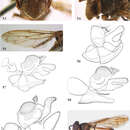Furcantenna: Brief Summary
provided by wikipedia EN
Furcantenna is a genus of hoverfly from southwestern China, Nepal and Peninsular Malaysia, containing three species. Furcantenna yangi is only known from males. Furcantenna is similar to the genus Schizoceratomyia. The two genera differ from each other in the shape of the scutellum; in Furcantenna a deep medial sulcus in its posterior margin divides the scutellum into two lobes.
- license
- cc-by-sa-3.0
- copyright
- Wikipedia authors and editors
Description
provided by Zookeys
Body length: 9–10 mm. Broadly built flies with very wide head, long antennae and widened hind tibiae, bee mimics. Head much wider than thorax. Face slightly convex in profile; wider than eye; laterally depressed; medially weakly carinate. Lateral oral margins not produced. Vertex produced. Occiput ventrally narrow, dorsally widened. Eye bare. Eyes in male not convergent at level of frons; separated over distance much larger than width of antennal fossa. Antennal fossa about as high as wide. Antenna much longer than height of head; basoflagellomere bifurcate at base, with ventral branch a little longer than dorsal branch, both branches entirely long pilose; arista absent. Postpronotum pilose. Anepisternum sulcate. Scutellum apicomedially sulcate. Katepisternum dorsally pilose. Metasternum developed and pilose. Wing: vein R4+5 without posterior appendix; vein M1 perpendicular to R4+5 and M; crossvein r-m located around basal 1/5 of cell dm. Hind tibia and tarsus widened. Abdomen oval. Male genitalia: phallus slightly bent dorsad, with large spherical base; phallus furcate near apex; epandrium without ventrolateral ridge; surstylus approximately oval. Females unknown.
- license
- cc-by-3.0
- copyright
- Menno Reemer, Gunilla Ståhls
- bibliographic citation
- Reemer M, Ståhls G (2013) Generic revision and species classification of the Microdontinae (Diptera, Syrphidae) ZooKeys 288: 1–213
- author
- Menno Reemer
- author
- Gunilla Ståhls
Distribution
provided by Zookeys
Described species: 2. The type species was found in a mountainous area in southeastern China. The second known species, Furcantenna nepalensis sp. n., was collected in the Nepalese Himalaya at an altitude of approximately 1800 meters. The discovery of these species in these areas sheds an interesting light on the biogeography of the taxa with a furcate basoflagellomere in the male. Prior to the description of Furcantenna, such taxa were almost exclusively known from South America (except for the the apparently unrelated Australian Cervicorniphora). The occurrence of the obviously related (Reemer and Ståhls in press) Furcantenna in Oriental mountains on the Asian mainland could possibly be explained as a relict of a wider distribution in early eras.
- license
- cc-by-3.0
- copyright
- Menno Reemer, Gunilla Ståhls
- bibliographic citation
- Reemer M, Ståhls G (2013) Generic revision and species classification of the Microdontinae (Diptera, Syrphidae) ZooKeys 288: 1–213
- author
- Menno Reemer
- author
- Gunilla Ståhls

